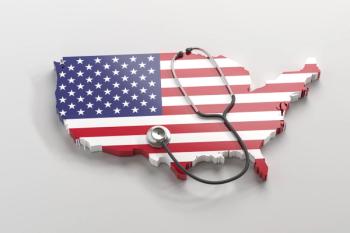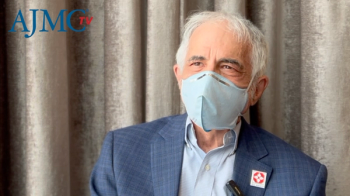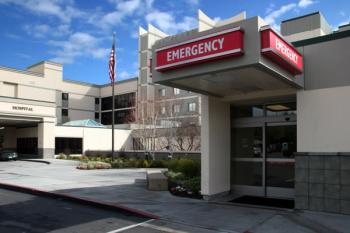
The American Journal of Managed Care
- April 2024
- Volume 30
- Issue 4
- Pages: e135-e139
Institutional Practices for Charitable Medication Access for Uninsured Patients
Analysis of a patient sample enrolled in charitable care at an academic medical center revealed that chronic medications were variably filled at a significant cost.
ABSTRACT
Objectives: To identify the most frequently prescribed medications, the location where prescriptions were filled, and whether a voucher was utilized among patients enrolled in a charitable care program within an academic medical center.
Study Design: This was a retrospective cohort study analyzing electronic health record and pharmacy dispensing information at a medical center’s outpatient pharmacies.
Methods: Patients included in this analysis were enrolled in a charitable care program and had at least 1 ambulatory encounter in a primary care clinic from March 1, 2019, to June 30, 2021. The study identified frequently prescribed medications, prescription payment methods, the overall cost of prescriptions if available, and the percentage of patients who filled their prescription at a medical center’s outpatient pharmacies vs external outpatient pharmacies. Descriptive statistics were used to describe the results.
Results: This study included 511 patients, 87% of whom were Spanish speaking. A total of 8453 prescriptions were identified, and more than half of the prescriptions were sent to external outpatient pharmacies. The most common medications prescribed were for cardiovascular disease, diabetes, and pain treatment. Forty-seven percent of all prescriptions were sent to the medical center’s outpatient pharmacies. The medical center’s charitable care program covered the costs of 44% of the prescriptions sent to internal pharmacies, assisting 148 unique patients and incurring a cost of $111,052 for the medical center.
Conclusions: Overall, this study was able to characterize patient demographics, historical costs related to charitable care coverage, and the utilization of health care services among this population. This information can be used to support the development and implementation of a charitable medication formulary, with the aims of improving quality of care for this population and reducing medical center costs.
Am J Manag Care. 2024;30(4):e135-e139.
Takeaway Points
Analysis of a sample of patients who were enrolled in a charitable care program at a large academic medical center revealed that prescriptions for chronic medications were variably filled at medical center outpatient pharmacies at a significant cost to the medical center.
- Commonly prescribed medications include treatments for chronic diseases and pain.
- Low-cost alternatives were preferred to more expensive treatments.
- Significant portions of prescriptions were filled at medical center outpatient pharmacies and were paid for by charitable care.
- Consistent access to medications should result in decreased costs to the medical center.
More than 28 million individuals younger than 65 years are uninsured in the US, and nearly half of them are unable to obtain insurance under the Affordable Care Act for a variety of reasons such as insurance premium affordability, immigrant status, and difficulty meeting requirements to apply for medical assistance.1 Those who are uninsured are at a disproportionately higher risk of cost-related medication underuse and nonadherence compared with patients who have health insurance.2
Cost-related medication nonadherence has also been associated with poorer health outcomes.2-5 One in 8 patients with atherosclerotic cardiovascular disease in the US, nearly 1.5 million patients, reports nonadherence to medications.6 These rates increase 3-fold among those who are uninsured or younger than 65 years.6 Patients with diabetes without health insurance demonstrated significantly more cost-related medication underuse and had higher hemoglobin A1c levels, more symptoms of hyperglycemia, and poorer physical functioning.7 Overall, poor medication adherence increases the use of costly health care services, dissatisfaction among patients and their providers, and morbidity and mortality.7,8
In academic medical centers, patients who do not have insurance may receive charitable care to defray the cost of medically necessary procedures and visits.9-11 Support for accessing outpatient medications and services varies across institutions. Medical centers may have a charitable mechanism to help patients fill their prescriptions, but this is generally limited to hospital discharge and may not be sustainable for longitudinal ambulatory care. In addition to the cost of medications, other barriers to medication access exist, including lack of transportation, language discordance, personal disability, difficulty identifying and enrolling in discount or manufacturer assistance programs for medications, patient hesitancy to discuss medication costs, and lack of provider awareness of the cost of medications.12-14
The provision of a free or reduced-price medication formulary at a medical center may address these barriers. An efficient and effective formulary can minimize the total cost of care delivery, improve patient access, and positively affect health outcomes, including quality of life.15 The purpose of this analysis is to inform the development and feasibility of a charitable medication formulary by describing the frequency and medical center cost of medications that were prescribed to a cohort of patients receiving charitable care.
METHODS
Study Design, Data Sources, and Patient Population
This was a single-site, retrospective observational study that analyzed both electronic health record information from Johns Hopkins Medicine East Baltimore Campus in Maryland and its outpatient pharmacies’ dispensing records. This study was approved by the institutional review board at Johns Hopkins Medicine (IRB00304646).
Patients included were 18 years or older and were uninsured. These patients were identified by having had at least 1 outpatient visit to the primary care clinic at the academic medical center between March 1, 2019, and June 30, 2021. Patient demographics, prescribing information, and health care utilization data were obtained. Prescription data included medication name, medication class, strength, days’ supply, refill quantity, date of prescription, and dispensing pharmacy location. If prescriptions were sent to the medical center’s outpatient pharmacies, payment information was obtained from pharmacy dispensing information. If prescriptions were filled at outside pharmacies, pharmacy dispensing information was not available.
Definitions, Measures, and Statistical Analysis
The study utilized prescriptions for this analysis. Due to limitations in accessing dispensing data at external pharmacies, the study team was unable to determine whether prescriptions sent to external pharmacies were refilled. Therefore, each prescription sent to an external pharmacy could be counted only once. Because internal dispensing data were available for medications sent to the medical center’s outpatient pharmacies, the study team was able to account for the cost of all prescriptions (initial fill and subsequent refills) that were filled at internal pharmacy locations.
The study identified frequently prescribed medications, the percentage of patients who filled their prescription at the medical center’s outpatient pharmacies vs external pharmacies, and prescription payment methods. In addition, the cost and proportion of prescriptions paid for by charitable care were of interest to the study team.
Payment methods were classified as charity (medical center paid medication cost), out of pocket (patient paid for the medication), alternative method (medication discount card, manufacturer coupons, or other forms of assistance), and unable to determine (when information was unavailable or if prescriptions were sent to an external pharmacy).
Descriptive statistics were reported for patient characteristic and health care utilization variables as well as for prescription data and payment methods using Stata software (StataCorp LLC).
RESULTS
Patient Demographics
Overall, 511 patients were included in this study, and their most notable characteristics are presented in
Prescription Payment Methods
A total of 8453 prescriptions were written during the study period. External retail pharmacies received 52% (n = 4404) of prescriptions during the study period, and the medical center’s pharmacies received 47% (n = 3972) (
Prescription Ordering Patterns
Part A of the
DISCUSSION
Patients without insurance are at higher risk for medication nonadherence, increasing the likelihood of negative health outcomes and leading to an increased total cost of care. Addressing financial barriers to longitudinal medication adherence requires a sustainable mechanism to ensure medication access. The purpose of this analysis was to characterize the medication needs of a cohort of patients enrolled in a charitable care program at an academic medical center. The results of this analysis can help inform the development of a charitable care medication formulary.
More than 40% of prescriptions that were sent to the medical center pharmacies were paid for by the medical center; however, a trend toward cost-conscious prescribing was observed. Guidelines from the American Diabetes Association, the American Heart Association, and the American College of Chest Physicians recommend newer (and costly) therapies such as sodium glucose cotransporter-2 inhibitors and glucagon-like peptide-1 receptor agonists for the treatment of diabetes and DOACs for anticoagulation due to their efficacy and more favorable adverse event profile.16-18 Although warfarin is less costly than a DOAC, warfarin therapy incurs additional costs due to necessary laboratory monitoring and ambulatory visits—costs that are absorbed by the medical center for patients enrolled in this charitable care program. Additionally, 21% of all antihyperglycemic medications (53% of insulins) prescribed were low-cost human insulin or human insulin combinations, which are not preferred in the guidelines due to safety concerns.
This study created a benchmark for health care spending and medication needs for uninsured patients enrolled in a charitable care program at a large academic medical center. The interpretation of this data provides insight into crafting a charitable care medication formulary that addresses treatment of the most common disease states for this population. There are many benefits to the patient, the medical center, and the medical team of adopting a charitable access medication formulary. Optimizing access to medications has the opportunity to reduce cost-based nonadherence and to improve guideline-based care.19 Utilizing a dedicated formulary sponsored by a medical center’s charitable care program can streamline prescribing, reduce personnel cost, and decrease acute care utilization.20-23 Utilization of medical center–based pharmacies will also provide the medical team with more accessible fill history and cost data; these data were sometimes not available due to sending medications to external pharmacies, where it was unknown whether patients picked up their medications.
For the subset of prescriptions filled at the medical center pharmacies during the study period, there was no existing systematic cost-conscious oversight of the prescribing process for patients utilizing charitable care. This study noted that there were 8453 prescriptions for 509 different generic medications. The provision of oversight and guidelines for prescribing medications according to a charitable access formulary will streamline prescribing and steer patients to low-cost therapies and interventions supporting use of higher-cost guideline-directed therapy. Although guideline-directed therapy may be prohibitively expensive for patients without insurance, oversight of charitable care prescribing can reduce overall cost of care while increasing medication access.24 Interventions include identifying and assisting patients with manufacturer assistance program applications and selecting a limited formulary based on 340B costs.25 In addition, oversight of a charitable medication formulary program would provide reinforcement to the medical staff regarding evidence-based medicine and cost of care for medical residents and learners at academic medical centers.
Limitations
There are several limitations to consider. First, this study was conducted with a retrospective, single medical center design, which may limit the generalizability of the results. Additionally, the research team was not able to obtain portions of information from external pharmacies that may have been helpful for this analysis. In addition, the SARS-CoV-2 pandemic occurred during part of the study period (March 1, 2019, to June 30, 2021), which may have impacted ambulatory health care utilization.
CONCLUSIONS
Although charitable care programs often support the medical needs of uninsured patients, there is often no ongoing mechanism within most medical centers to obtain access to medications. Uninsured populations are at higher risk of medication nonadherence. Although this analysis only identified commonly prescribed medications for patients enrolled in a charitable care program and their associated costs, its findings pave the way for improvements in charitable care–supported medication access, minimizing medication nonadherence, supporting guideline-based prescribing, and reducing the total cost of care.
Author Affiliations: Johns Hopkins Care at Home (AK, RG), Baltimore, MD; Johns Hopkins Medicine (CD-G), Baltimore, MD; Johns Hopkins University School of Medicine (RS), Baltimore, MD.
Source of Funding: This research received no specific grant from any funding agency in the public, commercial, or nonprofit sectors.
Author Disclosures: Drs Green and Stewart report that Johns Hopkins Medicine East Baltimore Campus could benefit from the implementation of a charitable formulary. The remaining authors report no relationship or financial interest with any entity that would pose a conflict of interest with the subject matter of this article.
Authorship Information: Concept and design (CD-G, RG, RS); acquisition of data (AK, CD-G, RG); analysis and interpretation of data (AK, CD-G, RG, RS); drafting of the manuscript (AK, CD-G, RS); critical revision of the manuscript for important intellectual content (AK, CD-G, RG, RS); statistical analysis (AK); provision of patients or study materials (AK); administrative, technical, or logistic support (AK, RG, RS); and supervision (CD-G, RS).
Address Correspondence to: Caitlin Dowd-Green, PharmD, MBA, Johns Hopkins Medicine, 600 N Wolfe St, Carnegie 180, Baltimore, MD 21287. Email: cdowd2@jhmi.edu.
REFERENCES
1. Garfield R, Orgera K, Damico A. The uninsured and the ACA: a primer - key facts about health insurance and the uninsured amidst changes to the Affordable Care Act. KFF. January 25, 2019. Accessed July 1, 2023. https://www.kff.org/uninsured/report/the-uninsured-and-the-aca-a-primer-key-facts-about-health-insurance-and-the-uninsured-amidst-changes-to-the-affordable-care-act/
2. Miranda AC, Serag-Bolos ES, Cooper JB. Cost-related medication underuse: strategies to improve medication adherence at care transitions. Am J Health Syst Pharm. 2019;76(8):560-565. doi:10.1093/ajhp/zxz010
3. Sokol MC, McGuigan KA, Verbrugge RR, Epstein RS. Impact of medication adherence on hospitalization risk and healthcare cost. Med Care. 2005;43(6):521-530. doi:10.1097/01.mlr.0000163641.86870.af
4. Roebuck MC, Liberman JN, Gemmill-Toyama M, Brennan TA. Medication adherence leads to lower health care use and costs despite increased drug spending. Health Aff (Millwood). 2011;30(1):91-99. doi:10.1377/hlthaff.2009.1087
5. Rasmussen JN, Chong A, Alter DA. Relationship between adherence to evidence-based pharmacotherapy and long-term mortality after acute myocardial infarction. JAMA. 2007;297(2):177-186. doi:10.1001/jama.297.2.177
6. Khera R, Valero-Elizondo J, Das SR, et al. Cost-related medication nonadherence in adults with atherosclerotic cardiovascular disease in the United States, 2013 to 2017. Circulation. 2019;140(25):2067-2075. doi:10.1161/CIRCULATIONAHA.119.041974
7. Piette JD, Wagner TH, Potter MB, Schillinger D. Health insurance status, cost-related medication underuse, and outcomes among diabetes patients in three systems of care. Med Care. 2004;42(2):102-109. doi:10.1097/01.mlr.0000108742.26446.17
8. Christensen AJ, Johnson JA. Patient adherence with medical treatment regimens: an interactive approach. Curr Dir Psychol Sci. 2002;11(3):94-97. doi:10.1111/1467-8721.00176
9. Lefton RB. Developing organizational charity-care policies and procedures. Healthc Financ Manage. 2002;56(4):52-57.
10. Chazin S, Friedenzohn I, Martinez-Vidal E, Somers SA. The Future of U.S. Charity Care Programs: Implications of Health Reform. Center for Health Care Strategies Inc. August 2010. Accessed July 1, 2023. https://www.chcs.org/media/The_Future_of_Charity_Care_Programs.pdf
11. Kemble S. Charity care programs: part of the solution or part of the problem? Public Health Rep. 2000;115(5):419-429. doi:10.1093/phr/115.5.419
12. Prescription drug discount cards: current programs and issues. KFF. February 2002. Accessed May 26, 2023. https://www.kff.org/wp-content/uploads/2013/01/prescription-drug-discount-cards-current-programs-and-issues-report-2.pdf
13. Patel HK, Dwibedi N, Omojasola A, Sansgiry SS. Impact of generic drug discount programs on managed care organizations. Am J Pharm Benefits. 2011;3(1):45-53.
14. Piette JD, Heisler M, Wagner TH. Cost-related medication underuse: do patients with chronic illnesses tell their doctors? Arch Intern Med. 2004;164(16):1749-1755. doi:10.1001/archinte.164.16.1749
15. Formulary management. Academy of Managed Care Pharmacy. July 18, 2019. Accessed May 28, 2023. https://www.amcp.org/about/managed-care-pharmacy-101/concepts-managed-care-pharmacy/formulary-management
16. American Diabetes Association. Standards of Medical Care in Diabetes—2022 abridged for primary care providers. Clin Diabetes. 2022;40(1):10-38. doi:10.2337/cd22-as01
17. January CT, Wann LS, Calkins H, et al. 2019 AHA/ACC/HRS focused update of the 2014 AHA/ACC/HRS guideline for the management of patients with atrial fibrillation: a report of the American College of Cardiology/American Heart Association Task Force on Clinical Practice Guidelines and the Heart Rhythm Society in collaboration with the Society of Thoracic Surgeons. Circulation. 2019;140(2):e125-e151. doi:10.1161/CIR.0000000000000665
18. Stevens SM, Woller SC, Kreuziger LB, et al. Antithrombotic therapy for VTE disease: second update of the CHEST guideline and expert panel report. Chest. 2021;160(6):e545-e608. doi:10.1016/j.chest.2021.07.055
19. Principles of a sound drug formulary system. American Society of Health-System Pharmacists. Accessed July 1, 2023. https://www.ashp.org/-/media/assets/policy-guidelines/docs/endorsed-documents/endorsed-documents-principles-sound-drug-formulary-system.pdf
20. Cutler RL, Fernandez-Llimos F, Frommer M, Benrimoj C, Garcia-Cardenas V. Economic impact of medication non-adherence by disease groups: a systematic review. BMJ Open. 2018;8(1):e016982. doi:10.1136/bmjopen-2017-016982
21. Zhang Y, Flory JH, Bao Y. Chronic medication nonadherence and potentially preventable healthcare utilization and spending among Medicare patients. J Gen Intern Med. 2022;37(14):3645-3652.
doi:10.1007/S11606-021-07334-Y
22. Rui P, Kang K. National Hospital Ambulatory Medical Care Survey: 2017 emergency department summary tables. National Center for Health Statistics. Accessed May 28, 2023. https://www.cdc.gov/nchs/data/nhamcs/web_tables/2017_ed_web_tables-508.pdf
23. Heaton PC, Tundia NL, Luder HR. U.S. emergency departments visits resulting from poor medication adherence: 2005-07. J Am Pharm Assoc (2003). 2013;53(5):513-519. doi:10.1331/JAPhA.2013.12213
24. Hung A, Blalock DV, Miller J, et al. Impact of financial medication assistance on medication adherence: a systematic review. J Manag Care Spec Pharm. 2021;27(7):924-935. doi:10.18553/jmcp.2021.27.7.924
25. 340B Drug Pricing Program. Health Resources and Services Administration. Accessed May 28, 2023. https://www.hrsa.gov/opa
Articles in this issue
over 1 year ago
Trends in Low-Value Cancer Care During the COVID-19 Pandemicover 1 year ago
Medication Persistence and Its Impact on Type 2 Diabetesalmost 2 years ago
Safety vs Price in the Generic Drug Market: MetforminNewsletter
Stay ahead of policy, cost, and value—subscribe to AJMC for expert insights at the intersection of clinical care and health economics.


















































